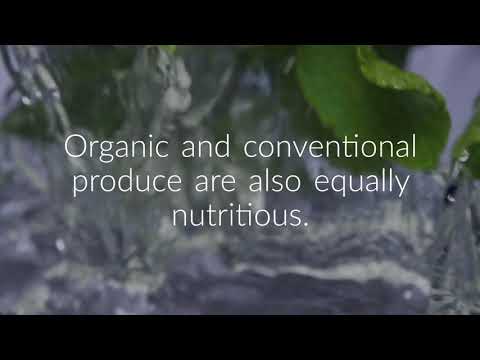Here comes another list wanting you to pick a winner in what we call the “conventional versus organic fruits and veggies boxing ring.” But the latest Environmental Working Group’s Dirty Dozen list doesn’t hold research-based water … or health benefits, for that matter.
We know many folks have heard that eating organic fruits and vegetables is good for you. This is true. But it is also true that eating conventionally grown fruits and vegetables is equally good for you.
Whether you prefer to eat organic or conventionally grown produce, you are choosing a safe and healthy way to access your daily fruits and vegetables. Here are four health and food safety facts to remember about fruits and vegetables the next time you hear about a “dirty” list of foods to avoid.
1. Both organic and conventionally grown produce are regulated for quality and safety by the federal government.
The United States food supply is not one that is haphazardly run. All food that is produced in our country and that is imported from other countries must adhere to regulations that include requirements covering the pesticides used for both organic and conventional farming. Yes, you read that right: Both organic and conventional farming use pesticides to produce food. The chemicals used in pesticides are regulated by the Environmental Protection Agency (EPA), the United States Department of Agriculture (USDA), and the Food and Drug Administration (FDA). These agencies monitor the types and amounts of pesticides used on all crops. Based on scientific evidence, these agencies have deemed the use of pesticides to be safe and determined that the residues that remain on produce, if any, do not cause adverse health effects.
2. Pesticide residues that may be found on either organic or conventional foods pose no health concern.
It is true that some fruits and vegetables can have minute amounts of pesticide residue present on them. Pesticides can remain on food for a short time after they have been harvested. Over time, exposure to oxygen and sunlight will cause these residues to break down and dissipate. By the time the food gets to you, there is little-to-no residue left.
Crops are constantly tested to make sure their residues are low and that the food that reaches us is safe. In fact, for over 25 years, USDA has tested a variety of commodities, including fresh and processed fruits and vegetables, dairy, meat, poultry, grains, fish, rice, specialty products and water, for pesticide residues. The most recent USDA Pesticide Data Program (PDP) Annual Summary shows more than 99 percent of the foods we consume had pesticide residues well below benchmark levels established by the EPA (the remaining less-than-one-percent had levels that were still not at harmful limits).
3. Shop using nutrition facts, not a list full of nonsense.
Many public health agencies and organizations, such as the World Health Organization, the American Heart Association, and the American Cancer Society have repeatedly affirmed that the increased consumption of fruits and vegetables have positive health impacts, and these organizations regularly encourage increased consumption of produce.
Many studies have demonstrated that organic produce does not have a nutritional advantage over conventional produce, and organic produce is not associated with better protection from chronic conditions like cardiovascular disease and cancer.
While many Americans don’t consume the daily recommended amount of fruits and vegetables in the first place, it is a public health disservice to encourage people to eat only organic produce. For example, some people who are told that organic is healthier and safer for them may lack access or enough money to purchase organic produce. According to a study led by researchers at the Johns Hopkins Center for a Livable Future, dietary messages in which people are made to believe organic fruits and vegetables are healthier can lead to unhealthy consequences. Fruits and vegetables are needed to establish healthy eating patterns, and they contain vital micronutrients like vitamins A, B, and C, as well as potassium, magnesium, and fiber.
We know that these annual lists may make it onto your social media feeds or that you sometimes may get an “informed” friend or family member rattling off “dirty” foods you should avoid, but we hope you’ll keep our food safety and nutrition facts in mind during your next stroll down the produce aisle. Being armed with this information can help you get your five-a-day serving without causing you to stress about the “organic versus conventional” title fight this year.

